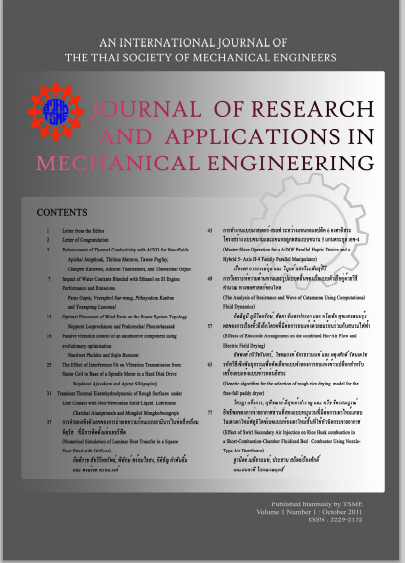A study of hydrogen addition on diesel oxidation catalyst activities under the real diesel engine
Main Article Content
Abstract
The impact of small hydrogen concentration (approximately 1000 ppm H2) on the performance of a commercial Diesel Oxidation Catalyst (DOC) in reducing carbonaceous components and oxidising NO into NO2 under actual diesel engine exhaust gas conditions has been investigated. The experimental work was carried out at steady-state engine conditions for the short time periods; hence the catalyst tolerance to sulphur was not investigated. Hydrogen addition enhances hydrocarbon (HC) and carbon monoxide (CO) oxidation at lower temperatures and promotes nitrogen oxide (NO) to nitrogen dioxide (NO2) oxidation in the diesel exhaust gas. Trends that are expected to enhance Diesel Particulate Filter (DPF) regeneration at low temperatures and improve the activity of other aftertreatment systems such as Lean NOx catalysts. The hydrogen benefit was found to be dependent on the engine operation (i.e. use of exhaust gas recirculation-EGR), space velocity, exhaust gas condition and composition.
Article Details
This work is licensed under a Creative Commons Attribution-NonCommercial-ShareAlike 4.0 International License.
References
[2] Satokawa S., Shibata J., Shimizu K., Satsuma A., and Hattori T. (2003). Promotion Effect of H2 on the Low Temperature Activity of the Selective Reduction of NO by Light HCs over Ag/Al2O3”, Applied Catalysis B: Environmental, 43, pp.179-186.
[3] Theinnoi K., Gill S.S., Tsolakis A., York A.P.E., Megaritis A., and Harrison R. (2012) Diesel Particulate Filter Regeneration Strategies: Study of Hydrogen Addition on Biodiesel Fuelled Engines, Energy & Fuels, 26 (2).
[4] Lee J.H., Paratore M., and Brown D. (2008) Evaluation of Cu-Based SCR/DPF Technology for Diesel Exhaust Emission Control, SAE Paper No. 2008-01-0072.
[5] Giovanni G., Jen H., Warner J.R., Girard J.W., Kim J.Y., and Lambert C.K. (2008) Enhanced Durability of a Ce/Zeolite Based SCR Catalyst, SAE Paper No. 2008-01-1025.
[6] Allansson, R., Blakeman, P. G., Cooper, B. J., Phillips, P.R., Thoss, J.E., Walker, A.P. (2002). The Use of the Continuously Regenerating Trap (CRTTM) to Control Particulate Emissions: Minimising the Impact of Sulfur Poisoning, SAE Paper No. 2002-01-1271.
[7] Hori, M., Koshiishi, Y., Matsunaga, N., Glaude, P., and Marinov, N. (2002). Temperature dependence of NO to NO2 conversion by n-butane and n-pentane oxidation, Proc Combust Inst, 29(2), pp. 2219-2226.
[8] Katare S.R., Patterson J.E., and Laing P.M, (2007) Aged DOC is a Net Consumer of NO2: Analyses of Vehicle Engine-dynamometer and Reactor Data, SAE Paper NO 2007-01-3984.
[9] York, A.P.E., Ahmadinejad, M., Watling, T. C., Walker, A.P., Cox, J.P., Gast, J., Blakeman, P.G., Allansson, R. (2007) Modeling of the Catalyzed Continuously Regenerating Diesel Particulate Filter (CCRDPF) System: Model Development and Passive Regeneration Studies, SAE Paper No. 2007-01-0043.
[10] Ladommatos N., Abdelhalim S. M, Zhao H., and Hu, Z. (1998) The effects of carbon dioxide in exhaust gas recirculation on diesel engine emissions, Proceedings of the IMechE Part D Journal of Automobile Engineering, Vol. 212, pp.25-42.
[11] Tsolakis A. (2006) Effects on Particle Size Distribution from the Diesel Engine Operating on RMEBiodiesel with EGR, Energy&Fuels, Vol.20, pp1418-1424.
[12] Tsolakis, A., Megaritis, A., Wyszynski, M.L., and Theinnoi, K. (2007) Engine Performance and Emissions of a Diesel Engine Operating on Diesel-RME (Rapeseed Methyl Ester) Blends with EGR (Exhaust Gas Recirculation), Energy, Vol. 32, pp.2072–2080.



